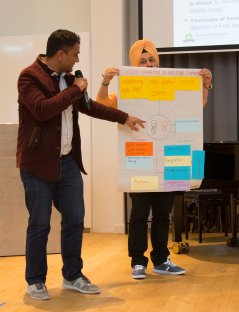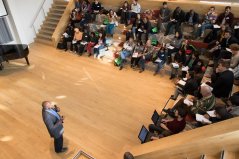
News
Blog: Creating Space for Youth Buy-In, Being Realistic about Contexts and their Challenges
By: Imme Widdershoven and Bram Peters
Wednesday 7th of March, the Seminar ‘Youth in Markets: Creating Space for the Buy-In’ took place at the Wageningen Campus. The seminar brought together a broad audience from NGOs, government, research, students of Wageningen University. One glance around the room showed a broad diversity in age and nationality as well, which, as would turn out, fit the diversity of the topic nicely.
Linking the diversity youth aspirations with socio-economic realities
Bram Peters (Wageningen Centre for Development Innovation) started the day with a short introduction. He explained how global challenges render the question of youth access to markets more relevant than ever: swift population growth in Africa and Asia, especially the rapidly growing youth number, poses challenges to markets that are not yet adapted to this influx of labour potential. Simultaneously, a food system transformation is needed to meet the ‘need to feed the 9 billion’. Trends of urbanisation and globalisation speed up the level of change, asking for a quick and adaptive responses.
As many young people grow up in rural areas, policy makers look in the direction of the agrifood sector to provide opportunities and solutions. However, youth interest in agriculture seems to be waning. This makes it important to look beyond questions about ‘make farming sexy’: beyond the traditional forms of farming, and rather focus on entrepreneurship and agribusiness by linking to market opportunities. In addition, the context and diversity of all young people need to be taken into account linked to structural transformation. These issues come together in the key question of the seminar: how to create space for the ‘buy-in’: how to connect youth aspirations with socio-economic realities?

From undeveloped boxes to innovation: Exploring youth in agriculture case by case
In order to find answers to the above question, six case studies were presented. All cases focused on a problem surrounding youth access to markets. The cases again reflect the complexity of the topic, as each case takes a different approach. Mandla Nkomo, from Solidaridad Southern Africa, kicked of the topic by outlining the urgency. The growing youth bulge comprises one of the most vulnerable groups. This means focusing on three elements: stimulating economic empowerment; enhanced youth civic engagement; and increased resilience building. Nicole Sloot (Agriterra) sought to explore this further, in the area of involving youth in agricultural cooperatives. Here the driving idea is that youth are keen on innovation and adoption of new technologies, and sustain cooperatives in the future. However, once youth participation mechanisms are in place, how to sustain that energy and expand it? Ardin van Emmerik (Youth Council Ede) articulated that organisations are always looking to ‘think outside the box’ to ensure innovation and flexibility. As this ‘box’ is created by years of experience, young people are best suited to this as they do not have that ‘box’ yet. Nicole and Ardin described the challenges in facilitating youth participation: how can we grab young people’s attention, and how to maintain momentum of youth participation, while ensuring the quality of the opportunities created? Simon Bailey (Aflatoun)added to this issue by stressing the importance of creating educational programs adapted to the specific wants and needs. He highlighted that young people in rural settings often have ‘mixed livelihoods’, comprising of activities such as farming, livestock keeping, entrepreneurial actions and social activities. The final two cases discussed the problems of access to markets when all other hurdles have been taken: what to do if youth are motivated and well-educated, but their access to the market is blocked?

Jemima Afari-Kwarteng and Rob Lubberink (WUR Management Studies Group) presented an example from Ghana, exploring the interface of individual ambitions and community goals. In this case of a cassava producing community, the link between youth and elders, and the economic and social demand for services are key factors. The last case, presented by Thijs van Bemmel (Bembem and the Next Economy) and Diwy Tomassen (1% Club and The Next Economy), described the market deadlock for entrepreneurial youth in Bamako, Mali, and asked how incubator programmes might develop exit strategies to maintain those businesses that were started.